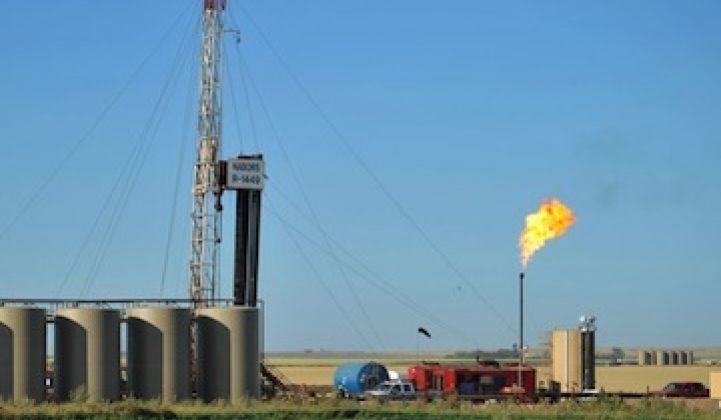A forthcoming book argues that the country's shale gas plays contain only about a quarter of the fuel that has been estimated by the U.S. Energy Information Administration, and other widely used industry and academic assessments.
Cold, Hungry and In the Dark: Exploding the Natural Gas Supply Myth by Bill Powers asserts that the quantity of unproved but technically recoverable natural gas in U.S. shale plays is approximately 127 trillion cubic feet, or about a quarter of the 482 tcf estimated by the EIA in its Annual Energy Outlook for 2012.
Powers, who publishes a newsletter for energy investors, argues that existing natural gas plays have not been nearly as productive as their backers predicted, and so cannot be expected to live up to expectations for future output.
"Recent drilling success has been extrapolated into the future," said Powers, who also sits on the board of the Calgary oil and gas company Arsenal Energy. "That's not supported by drilling history."
In Arkansas' Fayetteville Shale, 4,400 wells have produced 3.3 tcf since 2005, according to the Arkansas Oil & Gas Commission, or around a tenth of the 32 tcf that the EIA says is technically recoverable. In reality, Powers says, the Fayetteville Shale contains a total recoverable resource (TRR) of just 10 tcf.
In Louisiana, Arkansas and east Texas, the Haynesville Shale has produced around 5 tcf so far, Powers said. He predicted it has a total recoverable resource of 10 to 20 tcf, far short of the EIA's estimate of 75 tcf, a number Powers called "ridiculous."
Swimming Against the Current
He applies the same argument to Michigan's Antrim Shale, a play that has not been subject to the new wave of hydraulic fracturing and horizontal drilling that has made many shale beds economic, but whose long history since the mid-1980s shows production that he says has fallen short of expectations.
The Antrim has so far produced 3 tcf from some 10,000 wells, and its output has been declining since 1998, according to the Michigan Public Service Commission. Powers predicted the shale contains a TRR of 2 tcf, sharply lower than the 20 tcf predicted by the EIA.
Powers is the latest analyst to argue that the widely heralded shale gas "revolution" may be overblown. Other skeptics include Houston-based petroleum consultant Arthur Berman, who has long claimed that resource estimates are being overstated by energy companies seeking to defend their stock prices.
Berman, who writes the foreword to Powers' book, said the national gas resource, including proven reserves, is likely to equal about twenty-two years of consumption at the current rate, or less than a quarter of the 100 years' worth that is often cited by analysts and policymakers, including President Obama.
Berman's forecast is based on an estimate of probable reserves published by the Potential Gas Committee at the Colorado School of Mines, a 100-strong panel of company representatives that Berman called the "gold standard" of natural gas resource estimation.
"There is a great deal more uncertainty in this whole shale revolution than most people want to believe," Berman told AOL Energy. "There is definitely less gas than the propaganda says."
This is the first in a two-part AOL Energy series on the topic of U.S. shale gas reserves; here's Part 2.
***
Editor's note: This article is reposted in its original form from AOL Energy. Author credit goes to Jon Hurdle.



